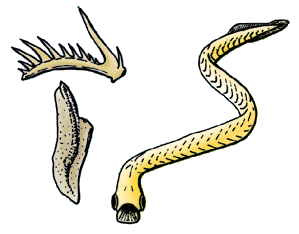Related Research Articles

Conodonts are extinct agnathan chordates resembling eels, classified in the class Conodonta. For many years, they were known only from tooth-like microfossils found in isolation and now called conodont elements. Knowledge about soft tissues remains limited. The animals are also called Conodontophora to avoid ambiguity.
The Tremadocian is the lowest stage of Ordovician. Together with the later Floian stage it forms the Lower Ordovician epoch. The Tremadocian lasted from 485.4 to 477.7 million years ago. The base of the Tremadocian is defined as the first appearance of the conodont species Iapetognathus fluctivagus at the Global Boundary Stratotype Section and Point (GSSP) section on Newfoundland.

Promissum is an extinct genus of conodonts, primitive chordates, that lived during the Upper Ordovician period.
In the geological timescale, the Llandovery epoch occurred at the beginning of the Silurian period. The Llandoverian epoch follows the massive Ordovician-Silurian extinction events, which led to a large decrease in biodiversity and an opening up of ecosystems.
Prioniodontida, also known as the "complex conodonts", is a large clade of conodonts that includes two major evolutionary grades; the Prioniodinina and the Ozarkodinina. It includes many of the more famous conodonts, such as the giant ordovician Promissum (Prioniodinina) from the Soom Shale and the Carboniferous specimens from the Granton Shrimp bed (Ozarkodinina). They are euconodonts, in that their elements are composed of two layers; the crown and the basal body, and are assumed to be a clade.
Periodon is a genus of conodonts which existed in what is now Canada, Iran, Argentina, China, Russia, and the United States during the Ordovician Period. It was described by Hadding in 1913, and the type species is P. aculeatus.
Iapetognathus is a genus of cordylodan conodonts. It is one of the oldest denticulate euconodont genera known.
Cornuodus is an extinct genus of conodonts.
Erraticodon is an extinct genus of conodonts in the family Chirognathidae.
Paracordylodus is an extinct genus of conodonts in the clade Prioniodontida, also known as the "complex conodonts". The species P. gracilis has been recovered from the chert of the Narooma Terrane, a geological structural region on the south coast of New South Wales, Australia.
Appalachignathus is a genus of multielement conodonts from the Middle Ordovician of North America.
Prioniodus is an extinct genus of conodonts in the family Balognathidae from the Ordovician.

Acanthodus is an extinct genus of conodonts.
Utahconus is an extinct genus of conodonts.

Variabiloconus is an extinct genus of conodonts.
Baltoniodus is an extinct genus of conodonts.
Microzarkodina is an extinct genus of conodonts mainly from the Middle Ordovician of Baltoscandia. The Microzarkodina apparatus probably consisted of 15 or 17 elements: four P, two or four M and nine S elements. The S elements include different Sa, Sb1, Sb2, and Sc element types.
Histiodella is an extinct genus of conodonts.
Protoprioniodus is an extinct genus of conodonts.
Prioniodinidae is an extinct family of conodonts in the order Prioniodinida.
References
- 1 2 Rossodus manitouensis (Conodonta), a New Early Ordovician Index Fossil. John E. Repetski and Raymond L. Ethington, Journal of Paleontology, Vol. 57, No. 2 (Mar., 1983), pages 289-301 (Stable URL)